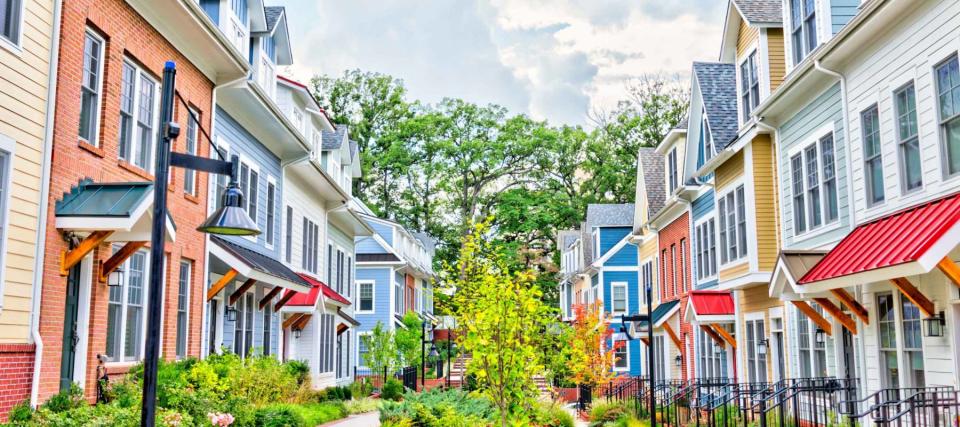Mortgage rates hold steady, giving refi holdouts another chance to save

Even as the demand for refinances slips, mortgage rates are staying solid — and that means homeowners sitting on the fence still have an opportunity to save themselves some real money.
For the second week in a row, mortgage rates in the U.S. have displayed minimal movement, according to a weekly survey by one of the country’s largest mortgage facilitators.
They may no longer be at the rock-bottom levels they hit in January, when COVID-19 was at its worst, but mortgage rates are still historically low. A refinance at today's rates can open the door to significant long-term savings on your mortgage.
30-year fixed mortgage rates

The average interest rate on 30-year fixed mortgages — the most popular choice for American homeowners — showed virtually no movement last week, rising from 2.87% to 2.88%, Freddie Mac reported on Thursday.
A year ago, the 30-year fixed was averaging a similar rate of 2.86%. So why, you might be wondering, are rates almost the same now even though the country’s COVID situation is worse than it was last September?
Even though more people are getting sick, the economy is still on the mend. Over two million jobs were created between June and August, and as the resulting income makes its way into the economy, it should become even more stable.
Keep in mind that it was lockdowns and stay-at-home orders, not the coronavirus itself, that throttled the economy and brought mortgage rates crashing down. That downward pressure just doesn’t exist today.
15-year fixed mortgage rates
The average interest rate on 15-year fixed mortgages also eked out a 0.01% increase, rising to 2.19% last week. A year ago, the 15-year fixed averaged 2.34%.
It’s important to note that Freddie’s figure is just an average. Lenders can be found offering rates of less than 2% on a refinance.
The 15-year fixed is a common choice for refinancing. The shorter term means borrowers pay less in interest than they would over the course of a 30-year mortgage. They get to own their homes sooner, too.
But because the loan term is shorter, the monthly payments involved are higher. That can be a hurdle for some borrowers.
5/1 adjustable mortgage rates
The average interest rate on five-year adjustable-rate mortgages, or 5/1 ARMs, edged down from 2.43% to 2.42%. At this time last year, 5/1 ARMs were averaging a rate of 3.11%.
ARMs are intriguing products. They combine the certainty of a fixed-rate mortgage with the uncertainty of adjustable rates — but that uncertainty can be a good thing, if interest rates decline.
Borrowers pay a fixed rate of interest during the first phase of the loan, but the rate periodically adjusts up or down after that. So a 5/1 ARM features an initial fixed-interest period of five years, followed by rate adjustments every year thereafter.
Rates won’t stay flat forever

While mortgage rates have remained stable for the past two weeks, there’s not a lot of evidence suggesting they’ll stay that way — or fall much further.
Sam Khater, Freddie Mac’s chief economist, points out in a statement that despite the country’s economic rebound losing a bit of steam during July and August, consumer confidence waning and inflation remaining high, mortgage rates “have stayed steady.”
Realtor.com chief economist Danielle Hale expects them to stay that way temporarily, at least.
“With little economic data on tap this week, mortgage rates are likely to remain in their holding pattern,” Hale says in a statement.
“However, with inflation a simmering concern, when mortgage rates do begin to move, they will most likely move higher. For homebuyers and refinancers alike, mortgage rates remain favorable, but may not remain so for long.”
How to secure a low rate for your refinance

MoneyWise recently conducted a survey of homeowners and found a shocking number of them don’t understand how much money can be saved with a refinance.
Even shaving $100 a month off your mortgage would save you $6,000 over five years. That's money that can be used to improve your home, fund your kids' education or invest for further gains.
If you're considering a refinance, there are a few simple things you can do to encourage lenders to offer you the lowest rate possible:
Check your credit score. The best mortgage rates tend to go to borrowers with the strongest credit. Take a quick, free look at your credit score to see what shape it's in, then consider doing a little rehab on your score before applying to a lender.
Diminish your debt. If you’ve accrued a pile of nagging, high-interest debt, lenders will wonder about your ability to make your mortgage payments. Rolling them all into a single, lower-interest debt consolidation loan can cut the overall cost of your debt, reduce the time it takes to pay it off and improve your cash flow.
Shop around. When it’s finally time to apply for your refinance, compare mortgage offers from at least five lenders. That’ll help you get the best mortgage for your budget and set yourself up for long-term success as a homeowner.
This article provides information only and should not be construed as advice. It is provided without warranty of any kind.
